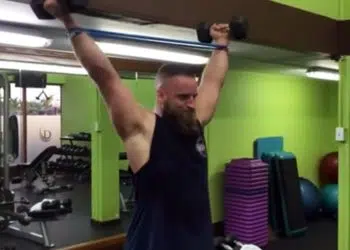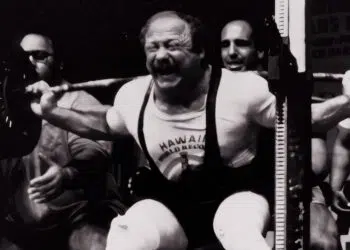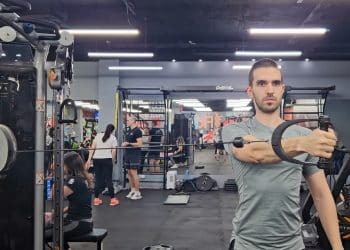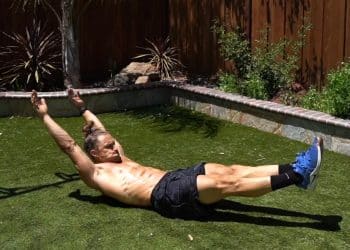When comparing suspension crunches (Also called knee tucks) vs. suspension pikes, they’re two different ballgames on the same field. Although both are lower core-focused exercises with an identical setup and starting high plank position, the former is a bent leg reverse crunch, while the pike is a straight-legged body fold.
They exist more or less for a similar purpose but only differ in technique which is what separates their skill level requirements.
For example, suspension crunches require less flexibility, are more straightforward (Pun intended), and are hence more beginner-friendly. While inverted pikes are less reasonable, more advanced, and hence higher on the ab gains reward tier ab. Both, however, are top-notch and their variations are absolutely awesome!
But today is all about suspension pikes for those of you who want a greater core challenge, and something to cure your training boredom yawns. This guide contains everything you need to get the best midriff gains and if you don’t have suspension straps, don’t cry cause we have other options for you too!
Muscles Worked During The Suspension Pike
Suspension pikes are an isotonic-isometric exercise that trains the core and hip muscles with traditional positive and negative style reps, while secondary muscles are activated to create stability and make the movement possible.
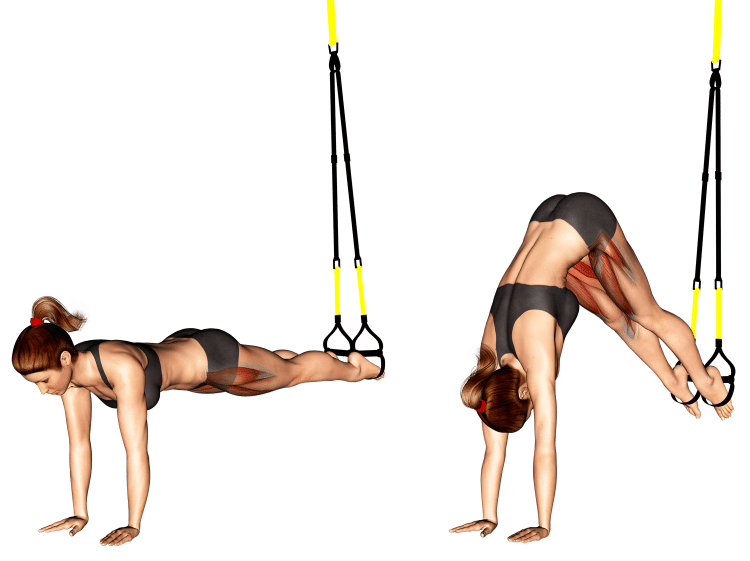
Learn about the muscles involved in suspension pikes.
Level Up Your Fitness: Join our 💪 strong community in Fitness Volt Newsletter. Get daily inspiration, expert-backed workouts, nutrition tips, the latest in strength sports, and the support you need to reach your goals. Subscribe for free!
- Core – Part of the pull (Lifting the hips) should occur from your core, or abdominals. Pikes are not just a hip motion, but it’s natural for several muscles to create a pike.
- Iliopsoas – When you lift the hips, you’re using the strongest thigh flexors, aka iliopsoas.
- Shoulders – If we said suspension pikes were a core only exercise we’d be lying. Then again, you probably already gathered that from this section. Your arms and shoulders do have to hold your body up, and while you’re not shoulder pressing, you’re using isometric strength.
- Adductors – While not as obvious compared to the roles of your abs and hips, adductor muscles pull the thighs in to stabilize the leg and keep them in position during the movement.
- Quadriceps – It’s no squat, but the straight leg position during suspension pikes requires quadriceps strength to keep the knees extended. If you don’t know, the quadriceps, or quads for short, are five muscles (Yes despite the name) on the front part of your upper leg. The fibers extend through your hips and knees, which allows them to function at both ends (Hip flexion and knee extension).
- Sartorius – The longest muscle in the human body (Whoa bet you never knew that!)… sartorius is a hip and knee muscle on the front upper leg. As a result, it helps rotate thigh, and flex the knee joint.
- Tensor fasciae latae – Neither a type of latte or Starbucks drink if that’s what you were thinking (Get your mind out of the gutter). Tensor fasciae latae works with other muscles to stabilize and move the hip and knee.
How To Do The Suspension Pike
While the suspension pike itself is rather simple, make sure that you have adequate flexibility in your lower body muscles. If you have that, you’re mostly there. The other part is the cueing the right muscles to initiate the movement and activate the proper muscles.
Learn the suspension pike technique with the following step by step instructions below. Then make sure to watch the short video to double check your technique.
Step 1: Strap length
First and foremost, your straps need to be the appropriate length for suspension pikes. Otherwise you could limit the range of motion, and overload the joints.
For majority of exercisers, a good rule of thumb is to adjust the handles so the ends are roughly mid calf height when standing next to them for comparison. Feel free to adjust slightly if needed, and ensure you can train through the optimal range of motion.
Okay, now we’re ready to get our feet in position.
Step 2: Setting up your feet
There’s no one perfect way to get your feet in the suspension straps as it’s usually, well, up to you. But you can try the different methods to see if one of more efficient or comfortable for you.
Technique 1: Facing away from the straps while on your hands and knees, pull your ankles up behind you and slide the straps over your feet one at a time (As demonstrated in the video version below).
Techique 2: Lie on your back, lift your feet up, insert them through the loops, then flip over on your hands and knees.
Pro tips:
- Make sure the strap is over the center of your foot, not over the toes.
- Keep your toes lifted toward your shins during the exercise to keep the straps secured.
Now you’re ready for the plank pose.
Step 3: Starting high plank
With your hands shoulder width apart on the floor, extend your elbows and push up onto your arms to come into a high plank with the wrists and shoulders vertically aligned.
Then tense your core muscles, and push your feet back to straighten your legs behind you, forming a straight line with your body.
Push your hands into the floor, and push your shoulders forward, don’t retract them for this exercise.
Step 4: Pike
To pike, flex your quads and glutes, then lift your butt as high as you can, while using your lower abs to pull the thighs into the stomach, and pulling the straps forward with your toes.
The butt should end up nearly directly over your shoulders with the head upside down between your arms.
Step 5: Reverse and repeat
Slowly drop your hips to straighten your body back to the starting position, then you can repeat steps 4 and 5 until you determine your set is complete.
Rest for a minute or so, then do two more sets to ensure you’ve trained the target muscles more thoroughly.
Watch how to do the suspension pike in under one minute via the YouTube tutorial included below.
Tips
- Walk your hands further forward to make the exercise more challenging, or vice versa.
- Keep in mind, there are many ways to place your feet in the straps. The above video example just shows one way to do it. You could also sit on your butt facing the straps then slide them over your feet, and flip over into position. Or have someone assist you.
This Exercise:
- Target muscle group: Core
- Type: Hypertrophy, strength, and function
- Mechanics: Isolation
- Equipment: Suspension straps setup
- Difficulty: Intermediate
Benefits Of The Suspension Pike
Here’s why you should consider adding suspension pikes in your ab training routine.
Build head to toe benefits
Listen, there’s not a muscle left out during suspension pikes. And while they don’t scream beginner friendly nor super advanced ab exercise, anyone can expect to get some benefit from them in some way, inverted V shape, or form.
With a combination of instability, unconventional posture, upper body strength demands, and hip/core power combo, suspension pikes are a potent total body movement.
Get a wicked strong core
You don’t even need suspension straps to get a preview of how challenging suspension pikes can be. You can replicate a similar technique right now where you are with sliding pikes. Which are one of the variations listed below, so make sure to scroll down and try it out.
Increasing core strength will give you an edge in every aspect of life from sports performance, to weight training, daily physical activities, and a healthy lower back. It is one of the important foundational muscle groups for life in general.
Healthier, more resilient hips
Bending, lifting the legs, and pretty much doing anything requires healthy hips. And they do contain muscles like any other body part, and will benefit from weight bearing exercises.
Not only does direct hip flexor training improve general physical performance, but it staves off injuries which can be incredibly debilitating (1, 2).
In one study, thirteen men and eleven women underwent an 8-week hip flexor training program, with a similar ratio of participants for a control group. The primary test group saw improvements in sprint and agility performance, while the control group experienced no changes (1).
Level Up Your Fitness: Join our 💪 strong community in Fitness Volt Newsletter. Get daily inspiration, expert-backed workouts, nutrition tips, the latest in strength sports, and the support you need to reach your goals. Subscribe for free!
The takeaway from this study was that hip flexor focused resistance training can have a significant positive impact on thigh flexibility, and several physical performance factors.
Suspension pikes are one variation of resistance training that can enhance hip function.
Inversion technique
While there may not be sufficient evidence to say definitely, some research has suggested that flipping upside down can have health benefits. Although pikes are a partial form of inversion.
But the potential said benefits include relieving back pain, promoting a healthier spine, and even enhancing cognitive function from increased blood flow to the brain. Perhaps it’s the element of stretching out the back that contributes to possible improvements.
Stretch your legs and back
Pikes can feel like a really intense stretch, and if you’re not flexible, you’ll quickly fold under pressure, or succumb to a more limited range of motion. If you don’t have adequate flexibility, you won’t be able to maintain straight legs which could cost you optimal core activation.
Common Mistakes During The Suspension Pike
While you won’t be damned for these training hiccups, well, you’ve been warned. Avoid these bad suspension pike training habits.
Not engaging your core
The newbie may wonder what’s going on in the suspension pike. Consequently, if attempting for the first time, you could easily get it wrong. Although we did establish that it’s a core exercise several times in this guide.
With that said, it’s hard not to engage your core muscles, and you should feel them activate instantly as you pitch your butt high.
Heavy or light hips/misalignment
Referencing the position of your hips, don’t sag (Heavy) or lift your butt too high (Light) in the tall plank pose. And there are obvious reasons for this.
Sinking hips stress the lower back and are a sign of a weak core. High hips are also usually due to a weak midsection, plus it reduces trunk activation, and reduces range of motion.
So while we don’t recommend either, high hips are better than low hips any day of the week.
The core and hips contribute to proper training alignment in plank positions, which transfers to efficient energy transfer.
Bent knees
While it’s not a crime, bending the knees too much isn’t a proper pike technique. If you want to go that route, knees tucks are more suitable.
Try to keep your legs mostly straight to create that inverted V, and attack the abs with different movement mechanics. After all, that’s what makes the pike special, it’s straight legged.
Variations And Alternatives Of The Suspension Pike
The purpose of this section is to show you the coolest variety of exercises similar to suspension pikes. And if you don’t already have a swiss ball, we recommend picking one up for the home-friendly version of ab pikes.
Swiss ball pike
Starting off our list of best suspension pike alternatives, swiss ball pike are one of our favorite ways to overload the core and really dig into that lower ab activation.
You have to be focused during swiss ball pikes because your feet are not secured inside any straps. That makes this one more risky and we only recommend it for more advanced exercisers with adequate training technique and experience.
But hey, if you train at home or don’t have a suspension setup then this is a similar alternative.
Steps
- Get in a high plank push-up pose with your hands about shoulder width apart.
- Extend your legs behind you and prop your shins up on the swiss ball one at a time.
- With your body straight from head to toe and abs engaged, press your palms hard into the floor and push your shoulder forward into a protracted position.
- Now push your butt toward the ceiling, and use your abs to suck the thighs into the stomach. You should feel an amazing contraction in your midsection.
- To finish, slowly drop your butt down to the beginning pose.
Pro tip: Take your time, and move at a slower tempo to ensure you’re training your abs symmetrically, and maintaining balance.
Swiss ball pike with knee tuck
If you need a swiss ball variation that’s less challenging than the previous obvious, go for the swiss ball knee tuck. The advantage of this exercise is better stability since more of your body is in contact with the ball. Another difference here is you’ll start with your upper legs on the ball rather than your shins.
Steps
- Get in a push-up pose with your hands roughly shoulder width apart, and place the top of either thigh on the swiss ball. Then bring the other leg on top of the ball.
- Tense your abs then lift your butt in the air while using your upper and lower core muscles to pull both sides toward each other.
- Then pull your knees into your chest.
- Push your feet back to straighten your legs and repeat.
Sliding pike
Got a pair of socks and slick floor? Or maybe you have some furniture sliders lying around. Either will do here, and you probaby get the concept. Using just your body weight and a proper feet and floor combination, you can mimic the benefits of suspension pikes.
Even if you don’t have adequate flexibility to complete this pose, you’re going to feel how insane it works your ab muscles without barely trying. Just because it’s natural to engage your ab during the hip lift.
Here’s a short demonstration of sliding pikes with instructions.
Steps
- Come into a push-up starting position with sliders under your feet.
- With a straight spine and body, push into the ground with your arms, then lift your hips toward the sky while pulling up with your abs.
- Lower your hips, slide your feet back and repeat.
V-ups
The inverted version of the suspension pike, yet with notable differences, V-ups are a well-known and more advanced bodyweight floor crunch variation. V-ups don’t involve the arm muscles and shoulders, like suspension pikes. And rather than lifting the hips, your butt stays in a single pose while the legs do all the moving.
One isn’t necessarily superior, however, use them together, or utilize V-ups when you don’t have suspension straps.
Suspension crunches
A suspension pike alternative but without the need to have flexible hamstrings and calves. Briefly mentioned at the start of this guide, suspension crunches are reverse crunches with a neutral body position which lends itself to being more novice friendly.
Check out our complete suspension crunch training guide.
FAQs
How many sets and reps should I aim for?
Because suspension pikes are a bodyweight exercise, and involve a pretty straightforward technique, we recommend aiming for near to complete failure sets. Performing reps until your muscles are too tired to continue.
As a basic training rule, aim for 2-3 sets per exercise session, and combine suspension pikes with other related movements that target the core muscles.
My hamstrings and calves hurt during pikes? What's the deal?
Unless you have prior injuries, you probably just need to stretch to improve your flexibilty and tolerance for similar exercises. This will also increase your range of motion in the future, allowing you to gain more benefits from your training.
Are pikes a safe exercise?
Generally, yes, if you have sufficient core strength, posterior flexibility, shoulder health, and capable hip and core muscles.
Otherwise, proceed with extra caution and make sure you have optimal form to avoid discomfort or injuries.
Wrapping Up
An underappreciated technique, suspension pikes and their variations could be the missing ingredient that you needed to spice up your core workouts. A simple exercise modification and progression from suspension knee tucks, this stiff legged fold will incinerate your lower abs, strengthen your hips and shoulders, and stretch your entire body.
But what if you don’t have a TRX or alternative type of suspension trainer?
You need not worry. Any of the top notch variations and alternatives shown above are a suitable replacement. If possible, do them all and build a midriff that you’ve always dreamt of!
References:
- Deane RS, Chow JW, Tillman MD, Fournier KA. Effects of hip flexor training on sprint, shuttle run, and vertical jump performance. J Strength Cond Res. 2005 Aug;19(3):615-21. doi: 10.1519/14974.1. PMID: 16095411.
- Thorborg K, Bandholm T, Zebis M, Andersen LL, Jensen J, Hölmich P. Large strengthening effect of a hip-flexor training programme: a randomized controlled trial. Knee Surg Sports Traumatol Arthrosc. 2016 Jul;24(7):2346-52. doi: 10.1007/s00167-015-3583-y. Epub 2015 Mar 22. PMID: 25796586.
Interested in measuring your progress? Check out our strength standards for Shoulder Press, Reverse Crunches, Squat, and more.


